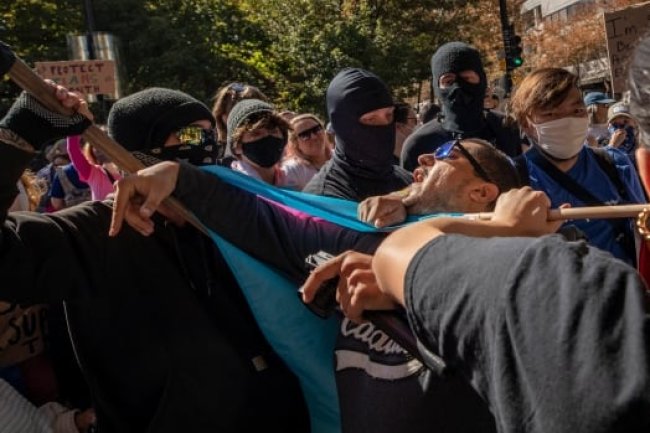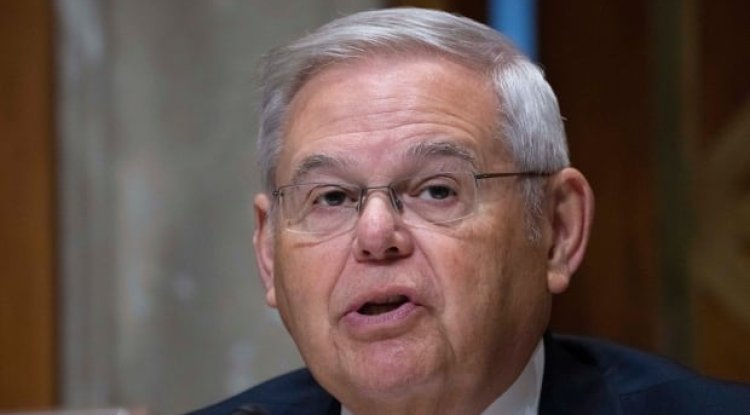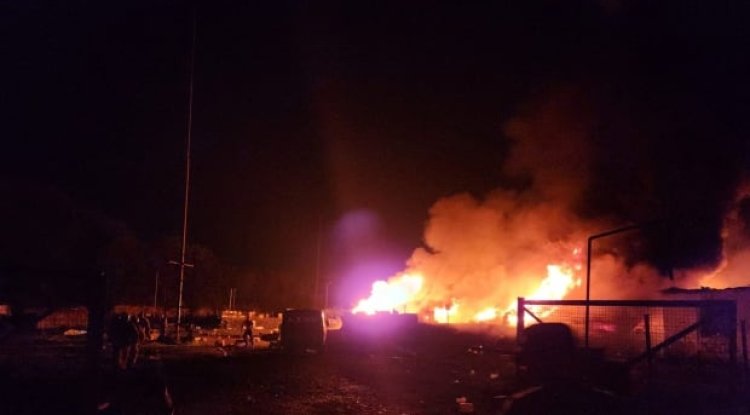Court hears of failed deal to move truckers during convoy protests
Tamara Lich and Chris Barber wait for the Public Order Emergency Commission to begin Nov. 1, 2022 in Ottawa. (Adrian Wyld/The Canadian Press)A lawyer for one of the leaders of what became the "Freedom Convoy" described in a criminal trial Wednesday how police assisted protesters into the city during the winter of 2022.Lawrence Greenspon, representing Tamara Lich, said protesters were invited into the city by police and told how to get into the city core."They were directed how to get off the highway, what roads to take, where to park in the downtown core of Ottawa and on Wellington Street," Greenspon said outside of court. "They didn't just end up there. They were directed there."He had spent the afternoon cross-examining Ottawa's manager of emergency and protective services Kim Ayotte, who was testifying in the trial.Lich and Chris Barber are charged with mischief, counselling others to commit mischief, intimidation and obstructing police for their role in the February 2022 protests a

A lawyer for one of the leaders of what became the "Freedom Convoy" described in a criminal trial Wednesday how police assisted protesters into the city during the winter of 2022.
Lawrence Greenspon, representing Tamara Lich, said protesters were invited into the city by police and told how to get into the city core.
"They were directed how to get off the highway, what roads to take, where to park in the downtown core of Ottawa and on Wellington Street," Greenspon said outside of court. "They didn't just end up there. They were directed there."
He had spent the afternoon cross-examining Ottawa's manager of emergency and protective services Kim Ayotte, who was testifying in the trial.
Lich and Chris Barber are charged with mischief, counselling others to commit mischief, intimidation and obstructing police for their role in the February 2022 protests against COVID-19 measures, as well as other grievances with the federal government.
The Crown is trying to establish Lich and Barber had "control and influence" over the crowds and encouraged others to join the protests while also fundraising.
"This case is not about their political beliefs," prosecutor Tim Radcliffe said in his opening. "What is at issue here is the means they employed — not the end — the means to achieve their political purpose, and whether it was lawful or not."
But Greenspon pointed to internal city notes and an Ottawa police traffic plan to show that protesters followed directions when they first arrived in the city.
"They were invited into the city of Ottawa. They were told how to get into the city core," he said.
Greenspon added it's "nonsense" to suggest — as Ayotte at one point did — that the protesters were only expected to stay for two days.
"There's no time limit on freedom," he said. "The Charter of Rights doesn't talk about the right to peaceful assembly for you know, up to 48 hours."
Greenspon said the city knew protesters were coming and booking hotels for 30 days and longer.
"And this this business about well, we only thought they're going to stay for two days," he said. "Nonsense."
Brokering deal to have trucks moved to Wellington
Ayotte said plans to keep an emergency lane open on Wellington Street, which runs directly in front of Parliament Hill, failed and were "lost" after the first night of protesting due to trucks being chained together to stop them from being moved.
But Greenspon argued Ayotte gave a different answer when asked about emergency lanes last year as part of a federal inquiry into the invocation of the Emergencies Act.
"Mr. Ayotte confirmed that convoy organizers had agreed to maintain an emergency lane and did, for the most part, maintain such a lane throughout the relevant period," a summary of his interview with the inquiry's lawyers stated.
Ayotte had affirmed the contents of that summary during the inquiry, and did so again during his testimony Wednesday.
He testified Wednesday that emergency lanes were mostly maintained throughout the rest of the protest zone, and that emergency response times were still within set standards.
Ayotte was one of the city officials involved in brokering a deal with convoy organizers to have protesters move trucks out of residential areas and onto Wellington.
He exchanged a series of text messages with Barber about moving trucks off residential streets.
On Feb. 13, former Ottawa mayor Jim Watson announced the details of a proposed deal with some protest organizers that would see 400 vehicles removed from residential areas.
Wellington Street was already home to dozens of large trucks, other vehicles and tents set up by protesters at that time.
But the plan to move the trucks ultimately didn't come to fruition.
Proposed deal came up at commission
Ayotte testified Wednesday that the city had limited information on police operations at the time.
At the Public Order Emergency Commission (POEC) held in October and November to examine the federal government's decision to invoke the Emergencies Act that ultimately ended the protests, more information about the proposed deal came to light.
Steve Kanellakos, who was the city manager during the protests, told the POEC there were concerns from other security forces with the deal to bring trucks onto Wellington.
The Parliamentary Protective Service (PPS), tasked with keeping government buildings in the area secure, disagreed with the city's arrangement with some convoy organizers.
"The [security service] expressed concern with respect to Wellington being turned into a parking lot of 200-plus trucks," reads a summary of an interview Kanellakos gave to the commission.
"The [police] then stopped moving vehicles close to Parliament Hill."

Evidence presented to the commission showed Larry Brookson, acting director of the PPS, took issue with the deal in an email he sent to Kanellakos.
"Quite honestly Steve I am at a loss as to how this sort of agreement could have been worked out with a clear disregard to security," the email said.
"Especially considering that we just finished a bomb blast assessment which included the threat of explosive being transferred via large vehicles."
The federal government was also not consulted on plans to move more trucks near Parliament Hill.
The commission heard the deal prompted about 40 large trucks and other light vehicles to leave five or six residential streets, but officials concluded protesters "did not respect their end of the bargain."
In court Wednesday, Ayotte testified that when he went to check if trucks had been moved, he saw none had left the city as was agreed upon. Instead, he said he saw vehicles "jockeying" for a better position closer to Wellington.
"Everyone was still trying to get closer to Parliament. There wasn't a lot of movement out of the city," he said.
By Feb. 14, after the deal failed, police started warning protesters that it was time to leave and when the weekend came a few days later, they used forced to clear anyone refusing to go. Ultimately more than 100 people were arrested as part of the sweeping police action.
Ayotte told court he observed the convoy protests from his office, by walking around and by viewing traffic cameras. He said he heard honking almost constantly over the first part of the protest but the noise became more sporadic after a court granted an injunction against honking downtown.
He also said the city received complaints about a diesel fume odour in the air, and he observed open fires on the streets.
Ayotte's cross-examination will continue Thursday.
The Crown had originally planned to call 22 witnesses over 10 days but proceedings are significantly behind schedule, and only three witnesses have completed their testimony.
What's Your Reaction?

















